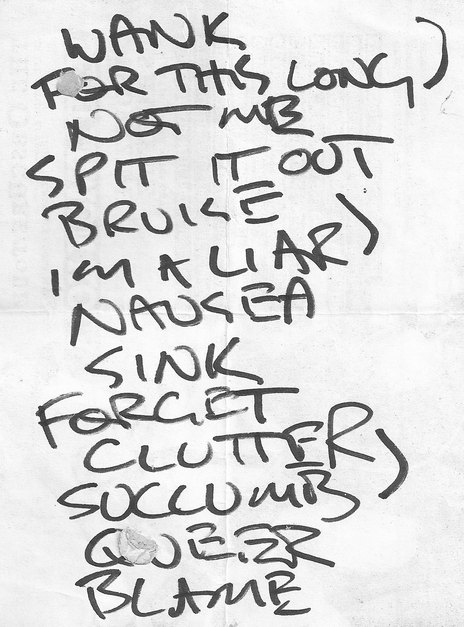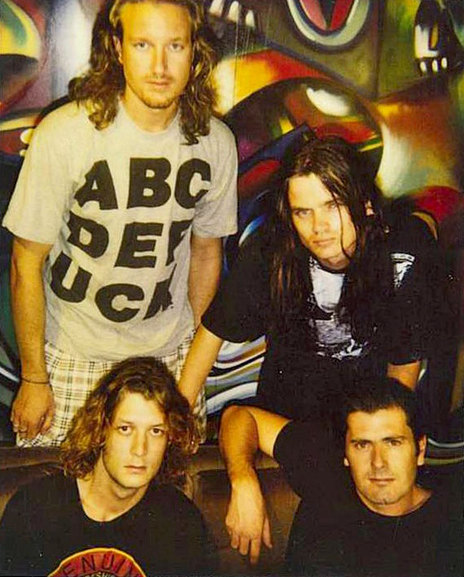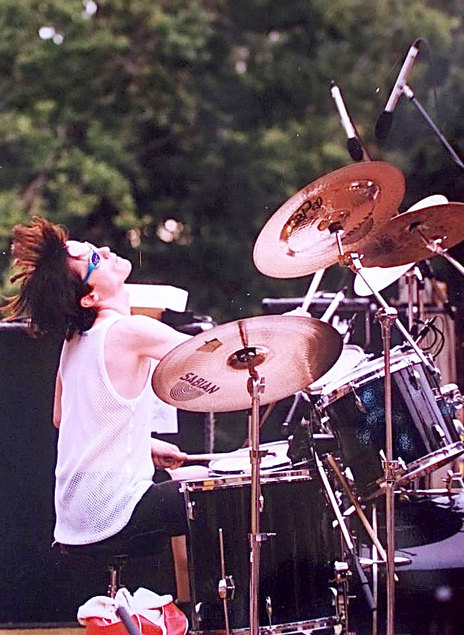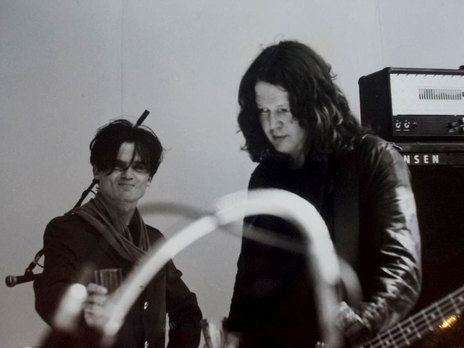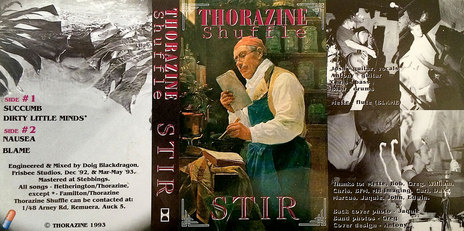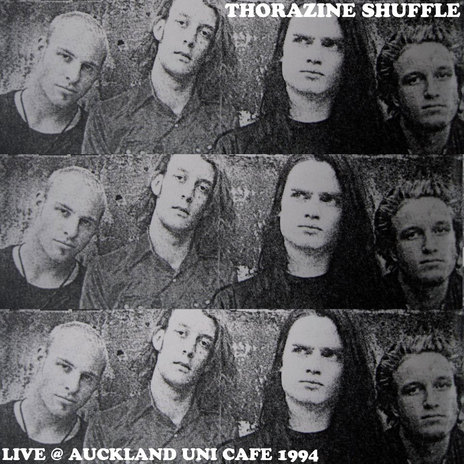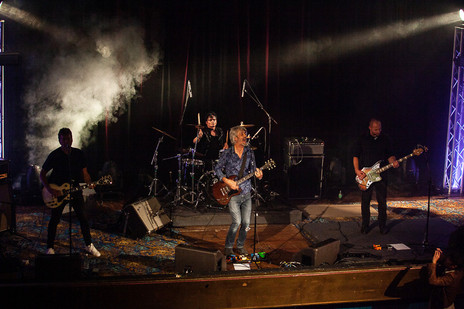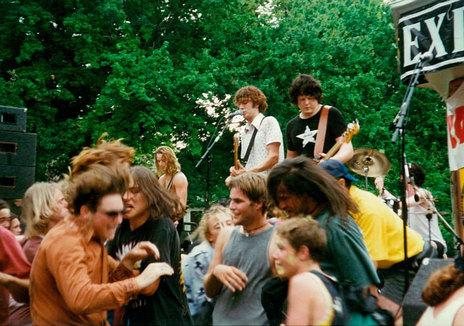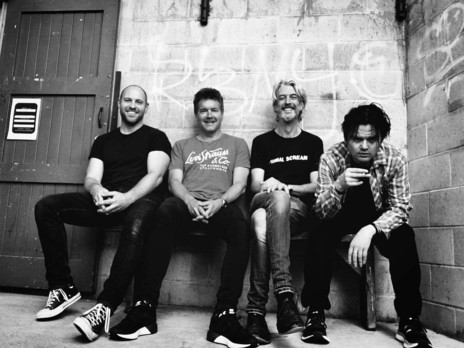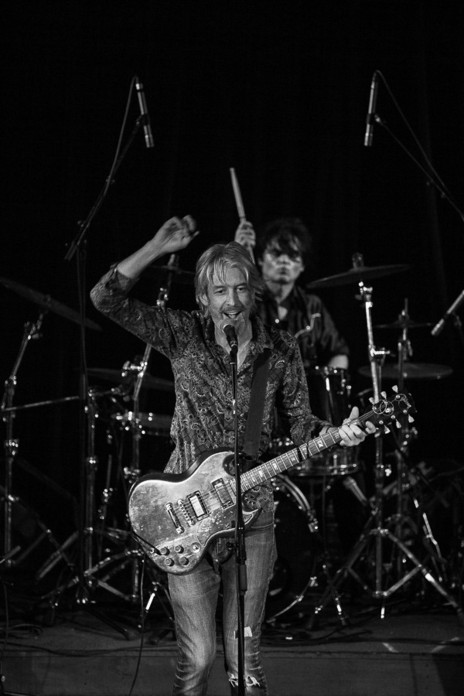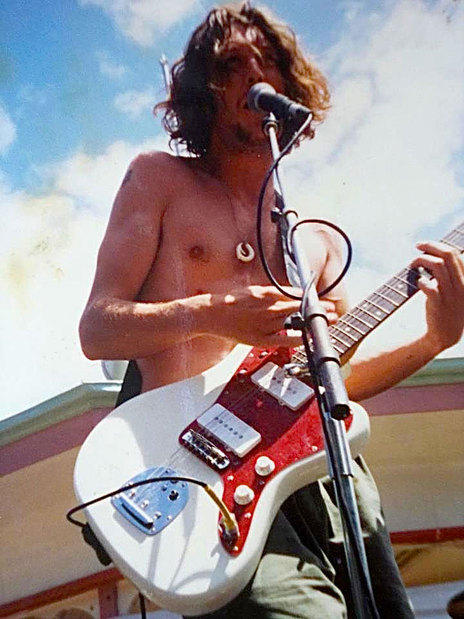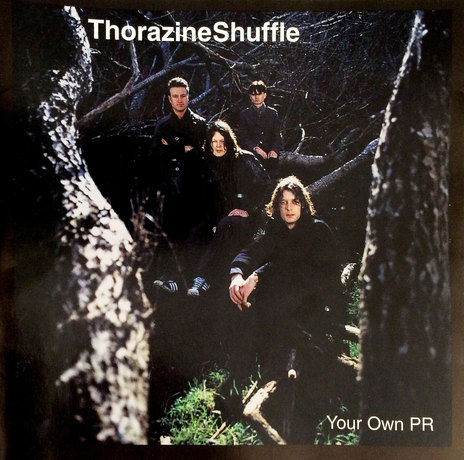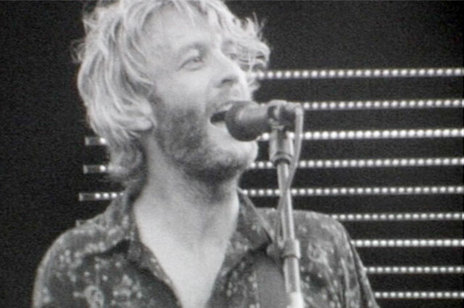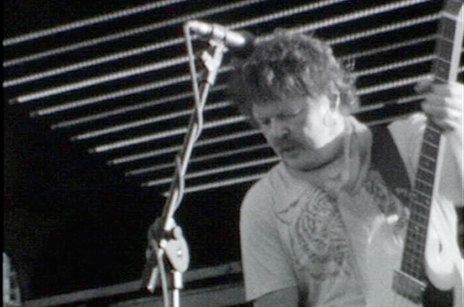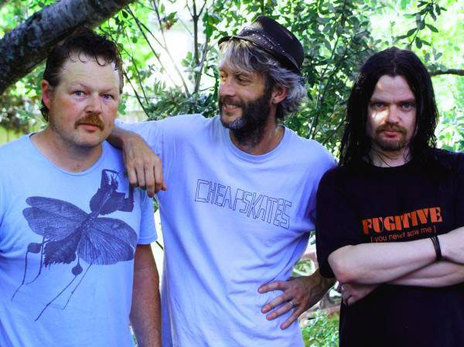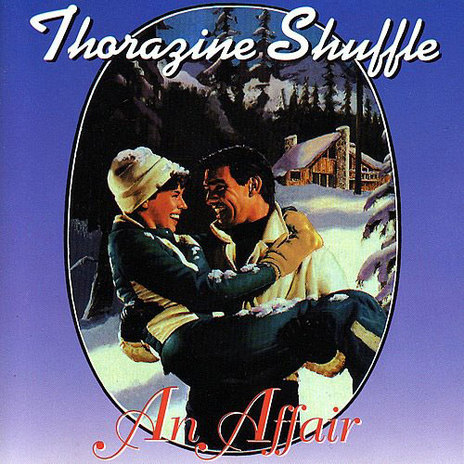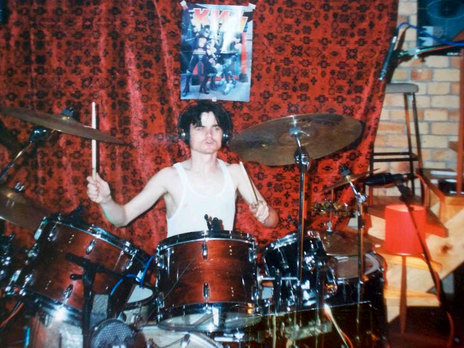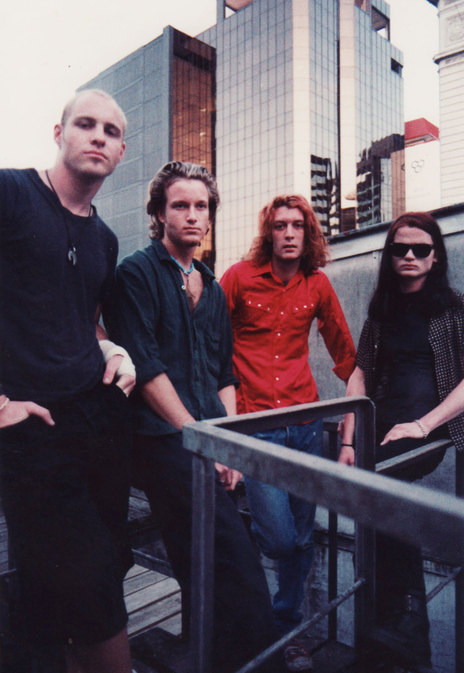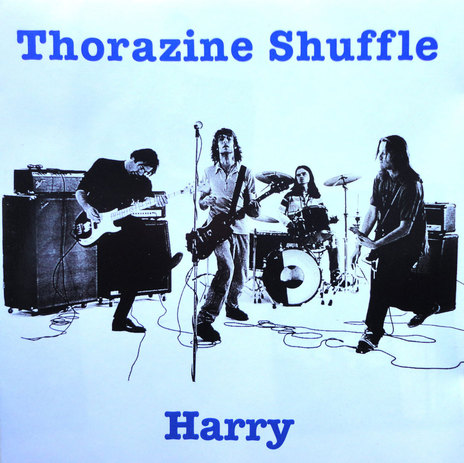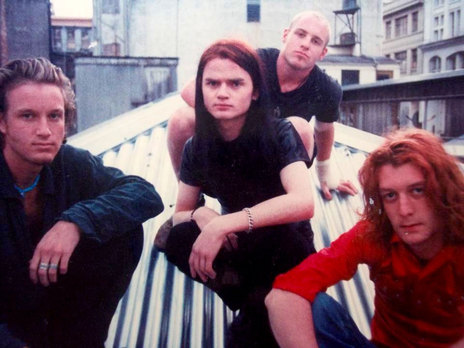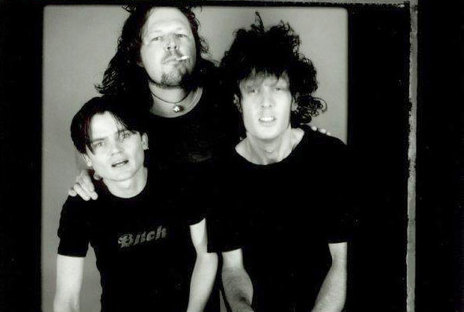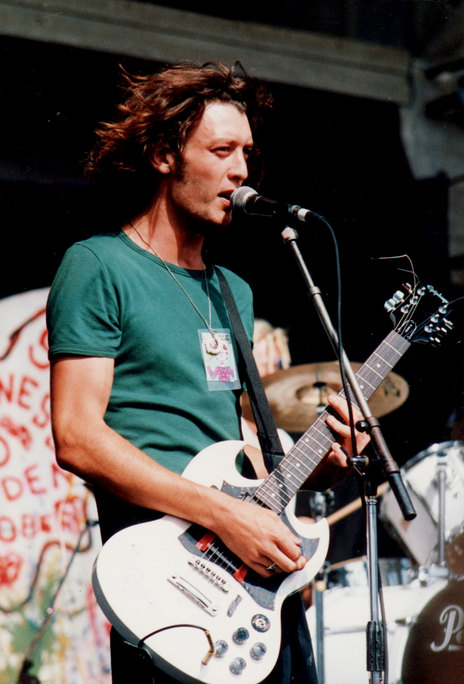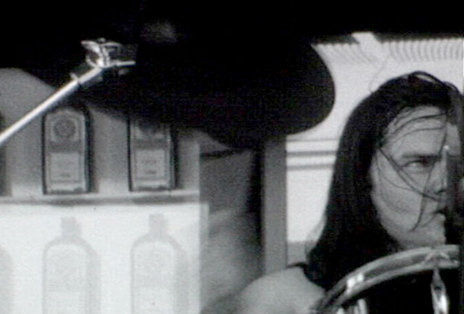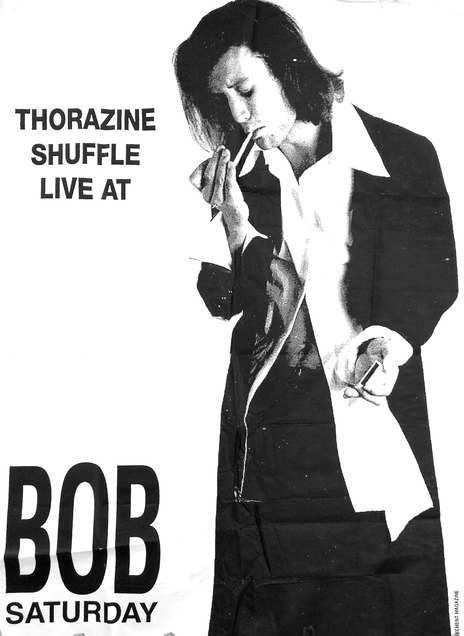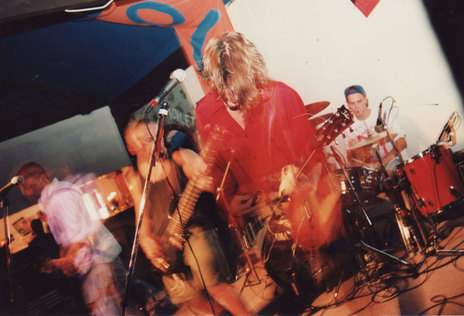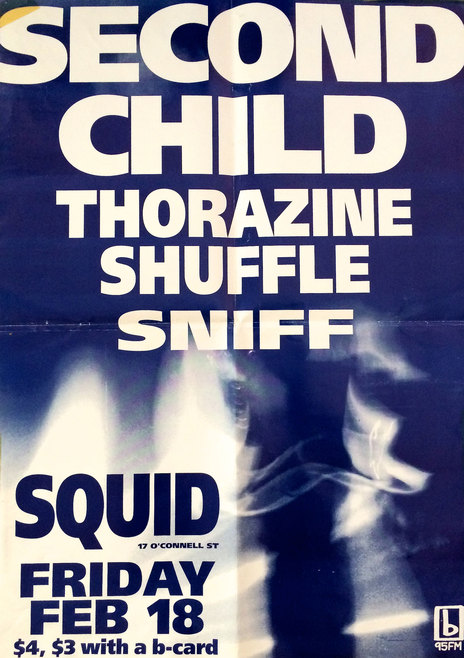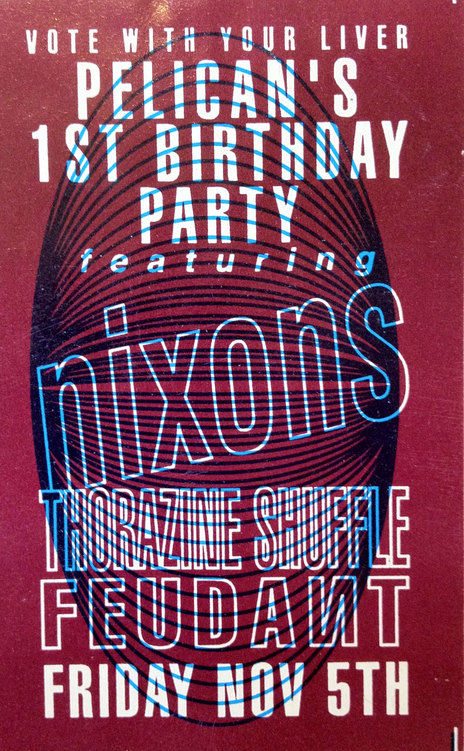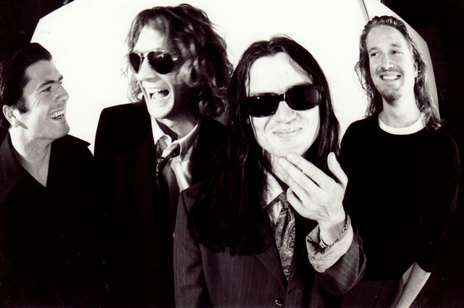“We’d been playing together (with few other people) for a couple of years. It was very tentative, though we had great aspirations. It wasn’t until we started practising above a costume hire shop and were looking for a vocalist and second guitarist that I met Josh Hetherington via mutual friends at Auckland University and we invited him along to play with us. As I recall, the musical vibe felt right straight away.”
Takeover of the Auckland live scene
Thorazine Shuffle’s first gig was at a friend’s party at Ellen Melville Hall in central Auckland, and they followed this with their first public performance at Ray Columbus’ Godfathers Club (within Abby’s Hotel) in November 1992. Their initial gambit for standing out from the other indie guitar bands of the time was to include a flute player – Mette Dale – in their line-up. Early live reviews seldom neglected to mention the girl in the miniskirt at the front of the stage.
Within a year Thorazine Shuffle had self-released a 4-track cassette EP, Stir (1993), which was recorded at Frisbee Studio.
Within a year Thorazine Shuffle had self-released a 4-track cassette EP, Stir (1993), which was recorded at Frisbee Studio. Hetherington also became a regular around the bFM office, though he found people overestimated how much this helped them get on air. “Graeme Humphries was an intimidating programme director and it wasn’t easy to get him to playlist a song, despite my best efforts at peddling a succession of demos. He rejected at least a couple of them and finally succumbed with ‘Succumb’.”
It wasn’t the only track off Stir to get radio play – they also had student radio hits with ‘Nausea’ and ‘Blame’ (the latter being listeners’ first opportunity to hear Dale’s flute playing).
They sold out of the first 200 tapes of Stir within a month and quickly organised a second run. This promising start put them alongside another rising, hip young band – Semi Lemon Kola (later called Propeller). The two groups became close friends, often playing together. Thorazine Shuffle topped off the year with the first of many international supports, opening for Fugazi at the Powerstation.
The band soon became known for their energetic live shows, which usually saw the boys stripping off their shirts after a few songs in (a common habit of bands at the time) and if things went particularly well (or badly) then guitars might be smashed or amps might catch fire. They also grabbed the audience’s attention with tracks like ‘Queer’ and ‘Wank’ which burned with youthful irreverence – demos of both tracks were recorded at bFM by Jules Barnett and grabbed more airplay for the group.
In 1994, they supported Supergroove for the North Island leg of their extensive Distraction tour. Through this connection, they befriended Stuart Broughton – the ex-manager of Supergroove, who was now acting as the band’s tour manager. Thorazine Shuffle were impressed with his early work with Supergroove and so signed him up as manager and their next two singles were released through his label, Chronic, which had distribution through BMG.
Their next demo, ‘Clutter’, dominated student radio throughout the country and helped lead to some great support slots, including opening for Redd Kross, The Beastie Boys and Helmet. The track was eventually released on the bFM compilation, Louder (1995). Like their two previous radio singles, it had been recorded by Jules Barnett (who also did their next single, ‘For This Long’), so it made sense when he joined the band soon after.
The addition of Barnett furthered the band’s status as an in-demand live outfit – his complex, yet powerful drumming style had been at the heart of the first Second Child mini-album, Magnet (1991). Barnett remembers being relieved by the chance to leave Second Child behind. “The pressure to constantly innovate and play intricate structures along with the angsty vibe of their music had grown tiresome at that point. I was secretly into Kiss and just wanted to rock out and shake my hair.”
Thorazine Shuffle’s reputation led to an epic run of shows during 1995.
Thorazine Shuffle’s reputation led to an epic run of shows during 1995 – they began the year by playing the Strawberry Fields festival and completing another national tour with Supergroove (the Distortion tour). Then there was the bFM Summer Series in Albert Park, a series of university orientation shows, and yet more support slots with international touring acts Silverchair and Grant Lee Buffalo. The band also gained underage fans by arranging their own all-ages shows or playing at venues with no age restriction, such as Ellen Melville Hall, the Powerstation, and Frisbee Leisure Lounge (the latter was a grassroots venue run at the top of Symonds St, by the same crew who ran Frisbee Studio).
Yet, Familton felt that one of their biggest steps around this time was their performance at Big Day Out in Auckland. “The previous year we were on a tiny stage buried under the stadium and wedged between concrete pillars and the toilets (which was still a blast to play) but within 12 months we had graduated to the much larger Big Top stage. It sounded huge, we played a killer set, the buzz from the crowd was genuinely exciting and for me it felt like a real defining moment in the band.”
The hard work on the live circuit had clearly been done and now all they needed was a killer single. Fortunately, they happened to have one up their sleeve.
Two singles
‘An Affair’ was centred around a sharp chorus hook – the drums dropped out so three stabs on the guitar could burst through, echoed by Hetherington singing ‘yeah, yeah, yeah’ in response. It also had a great video that showed a sunken cruise ship at the bottom of the ocean, inside which the band were apparently performing in an old-fashioned ballroom (filmed at live venue, The Club, on Queen St). The band received strong support from Auckland music video channel Max TV, which seemed to play the video hourly when it first came out.
The band received strong support from Auckland music video channel Max TV.
The path ahead seemed clear – push the single across to commercial radio and follow it quickly with another single, then an album. Yet this wasn’t a time when this course of action was easy to carry out. The band aspired to a full spectrum rock sound, so ‘An Affair’ had been recorded at York Street studio, which wasn’t a cheap option for a young indie band and it took time to gather money for a follow-up. Finally, Hetherington managed to get a Creative NZ grant for their next single, ‘Harry’ which was released in June 1996 (and featured the band’s new bass player, Murray Hood). It was a great, poppy tune and was promoted with a light-hearted video of the band being cornered in a clothing boutique by wild fans (a homage to the Technicolor footage of 60s pop mania).
That same year, Hetherington found the audience placed in front of even larger audiences: “I have fond memories of going on stage to 10,000 people at the Supertop when we toured with the Red Hot Chili Peppers. TV3 was filming us and there was just a huge roar when we hit the stage – I had to catch my breath just to sing the song. Stuart Broughton threw his arms around me after the show and handed me the bottle of Scotch he’d been nursing and was just so happy to be involved in a moment like that.”
These shows were the last for Mette, though she continued to occasionally record for the band and jumped up for live shows when available. The band continued onward, notching up a third slot at the Big Day Out in 1997 and supporting Everclear for a packed show at the Powerstation. Their incredible record on the live circuit had set them up well to finally release their debut album, but it turned out that this “much anticipated” album was still going to keep fans in anticipation longer than expected.
The long, long awaited debut album
Initial sessions for their debut album went well, with another Creative NZ grant providing the funds to book York St and hire experienced producer Karl Steven (singer and producer for Supergroove) and engineer Andrew Buckton (who had worked on the band’s previous singles). Top producer Malcolm Welsford even had some input at the mixing stages, so it seemed a potential breakthrough album was in the offing.
Yet their manager, Stuart Broughton, had quit his involvement in the music industry by this stage and moved overseas. This also ended their distribution deal with BMG, so it required some hard work by their new manager, Kate Ward, to secure a new distribution deal with Mushroom, along with a sufficient advance to complete the recording (Ward also started the label, Hapuka Records, to put out the release).
Another disruption had been the departure prior to recording of bass player, Murray Hood. Antony McDonald eventually left as well, though he did record his guitar parts during early sessions for the album, before deciding that he was sick of playing songs that were now years old and instead decided to leave NZ for an O.E. The band’s new bass player was Aaron “Captain” Carson (who was fresh from filling in with Dead Flowers) and this meant that all three members now worked at bFM – a situation that certainly wouldn’t harm their chances of getting played on the station.
Their first single off the album, now called Your Own PR, was another great, catchy number – ‘Emperor’s New Clothes’ – and they shot a video for it, though Max TV had since folded so it wasn’t seen as widely as their previous ones.
Hetherington remembers that the subsequent promotion for the album was strong, but short-lived: “We did as much as we could to support the album, particularly locally, and had a lot of PR and a great release show at the [Kings Arms]. But it wasn’t enough by any means. We didn’t even do a national tour. I went overseas in late 1999, which further stalled momentum ... We should have been onto the second album by the time we finished our first. To finish the album at all was a great and unlikely achievement in the light of the sort of production costs associated with the big studio and producer we felt the songs demanded.”
When Hetherington returned from overseas, the band released one last single, ‘More Than Anyone’, which showcased the quieter side of the band. Their last gig in this era was in mid-2000, though Hetherington recalls that there was never an official decision to break up. “Aaron left soon after that, then Jules. The band never really broke up actually – I’m its last remaining member!”
Barnett might’ve been the last to officially leave the band, but enjoys thinking back on his time with the band: “Hanging out with Chad Smith of Red Hot Chili Peppers and bonding over Spinal Tap was a highlight. I’ll always remember the smell of dry ice in the larger venues and the sound of those screaming Silverchair fans...”
Hetherington continued to work in the music industry after the dissolution of the group – working at bFM and launching the Groove Guide street press magazine for Real Groovy/Real Groove in 2003, as well as acting as its editor for 18 months.
He also started a new band, The Cosmetics, a name he’d previously used for a side project back in 1998. The resulting band was another three-piece, with Bill Kerton on drums and Vaughan Healy on bass, and they supported Fu Manchu.
These days he has a new project, Show Me Where It Hurts, with Ronny “Growler” Haynes (originally the drummer for Pash) and works part-time as a gig promoter.
A nice feature of the band ending on good terms with one another is that they can still occasionally be enticed to reform for a gig – they performed at bFM’s b street mini-festival in 2009 and then appeared at a reunion show by Delta the following year.
--
Jules Barnett passed away on 3 December 2024.
